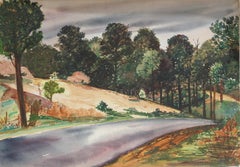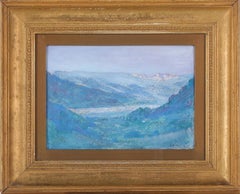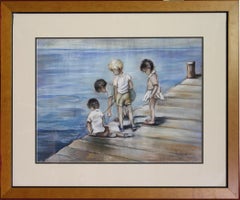Cardboard Landscape Drawings and Watercolors
to
1
Overall Width
to
Overall Height
to
1
1
1
1
1
1
1
3,044
12
12
12
2
3
2
1
1
1
1
Medium: Cardboard
Artist: Joseph Yeager
Country Lane in the Pine Forest - Mid Century Landscape Watercolor
Located in Soquel, CA
Wonderful mid century country lane in the pines landscape watercolor by Joseph Yeager (American, 20th Century). This piece is unsigned, but was acquired with a collection of Yeager w...
Category
Mid-20th Century American Impressionist Cardboard Landscape Drawings and Watercolors
Materials
Paper, Watercolor, Cardboard
Related Items
Mountain and Lake View, Gruyères
Located in Stockholm, SE
A watercolor depicting a mountain view and the lake Gruyère, (Lac De La Gruyère) in Switzerland by the American Impressionist and Tonalist Mary Rogers Williams (1857–1907). Signed M.R. Williams. On the verso, the artist wrote: ‘Painted in Gruyère July 1902.’ This is a newly discovered work by a rare woman artist who seldom appears on the art market. Small in scale, yet rich in atmosphere, power, and depth—a genuine little gem.
Mary Rogers Williams was born in 1857, in Hartford, Connecticut, the fifth of six children to a local baker. Orphaned by the age of fourteen, she pursued art with remarkable determination, studying at Hartford’s Decorative Art Society and the Art Students League in New York under William Merritt Chase. Her early mentor was James Wells Champney.
In 1888, she joined Smith College as associate professor of art, where she taught for nearly twenty years to help support her family. Alongside her academic career, she maintained a serious and evolving artistic practice, though much of it was pursued within the limitations of her era’s gender roles and financial pressures.
Her work is often classified as a blend of Tonalism and Impressionism—movements that were just taking shape during her lifetime. Tonalists used subdued palettes to evoke mood rather than detail, while Impressionists leaned toward brighter colors and broader subjects. Williams, working independently of art-world factions, forged a style rooted in mood, light, and atmosphere. She painted luminous pastels, watercolors, and oils—portraits, landscapes, and intimate studies of daily life.
Despite knowing figures like Whistler, William Merritt Chase, and Childe Hassam, she rarely aligned herself with any artistic “school” and found many male contemporaries pretentious or repetitive. She famously dropped out of Whistler’s Paris school, calling him “a pompous fop surrounded by fawners.” Though Mary Cassatt and Williams were both American Impressionists living in Paris, they never met—Cassatt enjoyed wealth and elite circles, while Williams was a self-reliant educator without patrons.
Williams traveled extensively throughout Europe—from the Arctic Circle to the ruins south of Naples—often alone or with her sister. She bicycled through fjords, hiked to medieval towns, and visited chateaux and harbors, all while sketching prolifically. She is likely the only 19th-century woman artist whose travels and daily life can be traced in such vivid, personal detail: what she ate, how she felt about fellow travelers, what she paid for trams, how the air smelled, what she wore, and how she missed home.
She documented everything—museum visits, church restorations, conversations with hotel guests, and her frustrations with men’s treatment of women artists. These letters, rediscovered in 2012 in a family boathouse, provide an extraordinary insight into not only her art but the intellectual and emotional texture of her life.
Her writings reveal not only artistic insight but the immense workload she carried. At Smith, she taught studio art and art history, organized faculty events, curated student exhibitions, wrote essays, handled housework, and even cooked and cleaned for her own lodgings. On vacations, she cooked for her family; in Europe, she waxed floors, painted walls, repaired clothing, and stoked fires—all while maintaining her painting and travel schedule.
Unlike many of her male peers, she had no assistants, no household staff, and little inherited wealth. Yet, as her letters reveal, she never saw herself as a victim—she relished challenges and even the absurdities of her era, from Italian waiters pushing marriage to department heads at Smith dismissing women’s artistic capacity.
Despite these challenges, Williams exhibited widely during her lifetime:
Paris Salon (1899)
National Academy of Design (1903–04)
Pennsylvania Academy of the Fine Arts
New York Water Color Club, American Water Color Society, Art Association of Indianapolis, and more.
She was praised in The New York Times, Hartford Courant, and Springfield Republican, and compared by peers to figures like Emily Dickinson—another New England woman of quiet yet profound artistic power. But unlike Dickinson, Mary Williams...
Category
Early 1900s American Impressionist Cardboard Landscape Drawings and Watercolors
Materials
Paper, Watercolor, Cardboard
Searching the Waters
By Lu Haskew
Located in Loveland, CO
Searching the Waters by Lu Haskew
Pastel 18x22" image size, 26x30" framed
Figurative Portrait of young children on a dock looking into the water.
ABOUT THE ARTIST: Lu Haskew 1921...
Category
1990s American Impressionist Cardboard Landscape Drawings and Watercolors
Materials
Watercolor
"Train Station, " Max Kuehne, Industrial City Scene, American Impressionism
By Max Kuehne
Located in New York, NY
Max Kuehne (1880 - 1968)
Train Station, circa 1910
Watercolor on paper
8 1/4 x 10 1/4 inches
Signed lower right
Provenance:
Private Collection, Illinois
Max Kuehne was born in Halle, Germany on November 7, 1880. During his adolescence the family immigrated to America and settled in Flushing, New York. As a young man, Max was active in rowing events, bicycle racing, swimming and sailing. After experimenting with various occupations, Kuehne decided to study art, which led him to William Merritt Chase's famous school in New York; he was trained by Chase himself, then by Kenneth Hayes Miller. Chase was at the peak of his career, and his portraits were especially in demand. Kuehne would have profited from Chase's invaluable lessons in technique, as well as his inspirational personality. Miller, only four years older than Kuehne, was another of the many artists to benefit from Chase's teachings. Even though Miller still would have been under the spell of Chase upon Kuehne's arrival, he was already experimenting with an aestheticism that went beyond Chase's realism and virtuosity of the brush. Later Miller developed a style dependent upon volumetric figures that recall Italian Renaissance prototypes.
Kuehne moved from Miller to Robert Henri in 1909. Rockwell Kent, who also studied under Chase, Miller, and Henri, expressed what he felt were their respective contributions: "As Chase had taught us to use our eyes, and Henri to enlist our hearts, Miller called on us to use our heads." (Rockwell Kent, It's Me O Lord: The Autobiography of Rockwell Kent. New York: Dodd, Mead and Co., 1955, p. 83). Henri prompted Kuehne to search out the unvarnished realities of urban living; a notable portion of Henri's stylistic formula was incorporated into his work.
Having received such a thorough foundation in art, Kuehne spent a year in Europe's major art museums to study techniques of the old masters. His son Richard named Ernest Lawson as one of Max Kuehne's European traveling companions. In 1911 Kuehne moved to New York where he maintained a studio and painted everyday scenes around him, using the rather Manet-like, dark palette of Henri.
A trip to Gloucester during the following summer engendered a brighter palette. In the words of Gallatin (1924, p. 60), during that summer Kuehne "executed some of his most successful pictures, paintings full of sunlight . . . revealing the fact that he was becoming a colorist of considerable distinction." Kuehne was away in England the year of the Armory Show (1913), where he worked on powerful, painterly seascapes on the rocky shores of Cornwall. Possibly inspired by Henri - who had discovered Madrid in 1900 then took classes there in 1906, 1908 and 1912 - Kuehne visited Spain in 1914; in all, he would spend three years there, maintaining a studio in Granada. He developed his own impressionism and a greater simplicity while in Spain, under the influence of the brilliant Mediterranean light. George Bellows convinced Kuehne to spend the summer of 1919 in Rockport, Maine (near Camden). The influence of Bellows was more than casual; he would have intensified Kuehne's commitment to paint life "in the raw" around him.
After another brief trip to Spain in 1920, Kuehne went to the other Rockport (Cape Ann, Massachusetts) where he was accepted as a member of the vigorous art colony, spearheaded by Aldro T. Hibbard. Rockport's picturesque ambiance fulfilled the needs of an artist-sailor: as a writer in the Gloucester Daily Times explained, "Max Kuehne came to Rockport to paint, but he stayed to sail." The 1920s was a boom decade for Cape Ann, as it was for the rest of the nation. Kuehne's studio in Rockport was formerly occupied by Jonas Lie.
Kuehne spent the summer of 1923 in Paris, where in July, André Breton started a brawl as the curtain went up on a play by his rival Tristan Tzara; the event signified the demise of the Dada movement. Kuehne could not relate to this avant-garde art but was apparently influenced by more traditional painters — the Fauves, Nabis, and painters such as Bonnard. Gallatin perceived a looser handling and more brilliant color in the pictures Kuehne brought back to the States in the fall. In 1926, Kuehne won the First Honorable Mention at the Carnegie Institute, and he re-exhibited there, for example, in 1937 (Before the Wind). Besides painting, Kuehne did sculpture, decorative screens, and furniture work with carved and gilded molding. In addition, he designed and carved his own frames, and John Taylor Adams encouraged Kuehne to execute etchings. Through his talents in all these media he was able to survive the Depression, and during the 1940s and 1950s these activities almost eclipsed his easel painting. In later years, Kuehne's landscapes and still-lifes show the influence of Cézanne and Bonnard, and his style changed radically.
Max Kuehne died in 1968. He exhibited his work at the National Academy of Design, the Art Institute of Chicago, the Carnegie Institute in Pittsburgh, the Memorial Art Gallery of the University of Rochester, and in various New York City galleries. Kuehne's works are in the following public collections: the Detroit Institute of Arts (Marine Headland), the Whitney Museum (Diamond Hill...
Category
1910s American Impressionist Cardboard Landscape Drawings and Watercolors
Materials
Paper, Watercolor
$2,800 Sale Price
20% Off
H 13.5 in W 15.5 in
"Canal at Indian Mound Road" RARE Ben Fenske Gouache work on paper black & white
By Ben Fenske
Located in Sag Harbor, NY
Painted during the 2015 Winter Equestrian Festival in Wellington, Florida. A black and white depiction of a canal, is barely recognizable, due to Fenske's wild brushstrokes and lack...
Category
21st Century and Contemporary American Impressionist Cardboard Landscape Drawings and Watercolors
Materials
Paper, Gouache
'Moss Beach, Monterey, California', Pacific Coastal Landscape, ASL NYC, Benezit
By Elmer Wachtel
Located in Santa Cruz, CA
An early-20th-century, landscape showing a view of the coastline at Moss Beach in Monterey County with slate-blue skies overhead and a view towards a stand ...
Category
Early 1900s American Impressionist Cardboard Landscape Drawings and Watercolors
Materials
Paper, Watercolor, Gouache
'Taos', American Watercolor Society, Chouinard, New York, Art Student's League
Located in Santa Cruz, CA
Signed lower right, 'James Vance, AWS', (American, 1919-2007), titled 'Taos' and painted circa 1950.
James Vance grew up in Los Angeles and first applied ...
Category
1950s American Impressionist Cardboard Landscape Drawings and Watercolors
Materials
Paper, Watercolor, Gouache
Mount Monadnock
By Gifford Beal
Located in Milford, NH
A fine monochromatic watercolor landscape painting of Mount Monadnock in New Hampshire by American artist Gifford Beal (1879-1956). Beal was b...
Category
Mid-20th Century American Impressionist Cardboard Landscape Drawings and Watercolors
Materials
Paper, Watercolor
Texas Coast Line with Shack
Located in San Francisco, CA
This artwork "Texas Cpast Line with Shack" 1964 is a watercolor on paper by noted Texas artist Jim Jones, 1922-1999. It is signed and dated at the lower right corner by the artist. T...
Category
Mid-20th Century American Impressionist Cardboard Landscape Drawings and Watercolors
Materials
Watercolor
"Monhegan Island, Maine, " Edward Dufner, American Impressionism Landscape View
Located in New York, NY
Edward Dufner (1872 - 1957)
Monhegan Island, Maine
Watercolor on paper
Sight 16 x 20 inches
Signed lower right
With a long-time career as an art teacher and painter of both 'light' and 'dark', Edward Dufner was one of the first students of the Buffalo Fine Arts Academy to earn an Albright Scholarship to study painting in New York. In Buffalo, he had exchanged odd job work for drawing lessons from architect Charles Sumner. He also earned money as an illustrator of a German-language newspaper, and in 1890 took lessons from George Bridgman at the Buffalo Fine Arts Academy.
In 1893, using his scholarship, Dufner moved to Manhattan and enrolled at the Art Students League where he studied with Henry Siddons Mowbray, figure painter and muralist. He also did illustration work for Life, Harper's and Scribner's magazines.
Five years later, in 1898, Dufner went to Paris where he studied at the Academy Julian with Jean-Paul Laurens and privately with James McNeill Whistler. Verification of this relationship, which has been debated by art scholars, comes from researcher Nancy Turk who located at the Smithsonian Institution two 1927 interviews given by Dufner. Turk wrote that Dufner "talks in detail about Whistler, about how he prepared his canvasas and about numerous pieces he painted. . . A great read, the interview puts to bed" the ongoing confusion about whether or not he studied with Whistler.
During his time in France, Dufner summered in the south at Le Pouleu with artists Richard Emil Miller...
Category
Early 20th Century American Impressionist Cardboard Landscape Drawings and Watercolors
Materials
Paper, Watercolor
Texas Coast Line
Located in San Francisco, CA
This artwork "Texas Cpast Line" 1964 is a watercolor on paper by noted Texas artist Jim Jones, 1922-1999. It is signed and dated at the lower right corner by the artist. The artwork ...
Category
Mid-20th Century American Impressionist Cardboard Landscape Drawings and Watercolors
Materials
Watercolor
An Old Military Road, The Road over Dovrefjell, Norway
Located in Stockholm, SE
Carl Oscar Borg (1879–1947)
An Old Military Road, The Road over Dovrefjell, Norway
gouache on paper, ca. 1900
signed
sheet 12.5 cm x 17.5 (4.9 x 6.9 in)
framed 23 × 28 cm (9 × 11...
Category
1890s American Impressionist Cardboard Landscape Drawings and Watercolors
Materials
Paper, Gouache
$2,882
H 9.06 in W 11.03 in
Canyon Country
By Lu Haskew
Located in Loveland, CO
Canyon Country by Lu Haskew
Pastel 16x20" image size
Landscape view of the Grand Canyon
ABOUT THE ARTIST: Lu Haskew 1921-2009
"Life is good to me. Being able to go to my studio five days weekly and paint for several hours, living in a supportive community, having family and friends who encourage me--all have contributed to helping me become an artist. Being fortunate to study with some of the artists I admire has kept me painting from the garden, people and my favorite things. With the support of galleries, teaching and doing demos, how could I do anything else? My goal is to try to be the best I can be by always being a student, looking for new ideas and stretching my horizons."
Upon retirement from a 33-year teaching career, Lu rented a studio in Loveland and began concentrating on
her oil and watercolor painting. Learning from artists she had followed and admired throughout the years
her painting became a full time career. Since 1992, she has studied with renowned painters Richard
Schmid, Clyde Aspevig, Joyce Pike, and others at the Scottsdale Art...
Category
1990s American Impressionist Cardboard Landscape Drawings and Watercolors
Materials
Watercolor
Cardboard landscape drawings and watercolors for sale on 1stDibs.
Find a wide variety of authentic Cardboard landscape drawings and watercolors available on 1stDibs. While artists have worked in this medium across a range of time periods, art made with this material during the 21st Century is especially popular. If you’re looking to add landscape drawings and watercolors created with this material to introduce a provocative pop of color and texture to an otherwise neutral space in your home, the works available on 1stDibs include elements of blue, green and other colors. There are many well-known artists whose body of work includes ceramic sculptures. Popular artists on 1stDibs associated with pieces like this include Henri Duhem, Maka Cielecka, Victor Isbrand, and Joseph Yeager. Frequently made by artists working in the Impressionist, Contemporary, all of these pieces for sale are unique and many will draw the attention of guests in your home. Not every interior allows for large Cardboard landscape drawings and watercolors, so small editions measuring 0.1 inches across are also available Prices for landscape drawings and watercolors made by famous or emerging artists can differ depending on medium, time period and other attributes. On 1stDibs, the price for these items starts at $49 and tops out at $985,000, while the average work can sell for $806.


